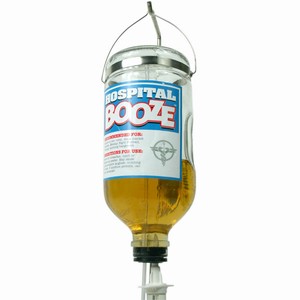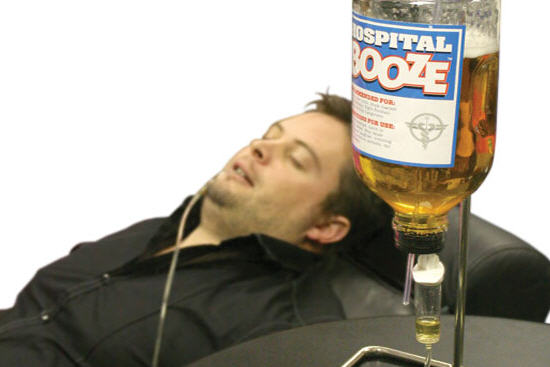
Study finds beer, red wine cure everything…except cirrhosis
Food producers love a good study, particularly one that finds that some ingredient or trace element in their product has some miraculous property found to cure cancer in rats. Such studies are guaranteed to make headlines around the world and lead to an aura being cast over their product. The wine industry in particular are masters of the self-serving study, with red wine being attributed all sorts of miraculous properties that should see it treated like the waters at Lourdes.
The chocolate industry has also discovered the value of good publicity and the media has recently reported chocolate manufacturing giants Mars and Barry Callebaut AG have announced a cross-industry partnership to promote the health benefits of cocoa flavanols.
The report says,
“Flavanols are a type of flavonoid – chemicals with antioxidant properties, found in green tea, berries, fruits, vegetables and red wine. Cocoa flavanols have been shown to improve blood circulation, protect skin from the effects of UV and potentially improve brain function.”
After more talk about the miracles of cocoa flavonols and the patented process pioneered by Mars which makes their chocolate better than any others, the article finally concludes with the warning:
“Critics warn that while the health benefits of flavanols are clear, the health-conscious should be careful when adding extra calories alongside. “An ounce of dark chocolate delivers about 150 calories. Eat that much every day without cutting back elsewhere and the girth you gain would far outweigh any benefit from chocolate.” says Dr. Thomas Lee, editor in chief, Harvard Heart Letter.
One hundred and fifty calories in an ounce of dark chocolate is 630 kilojoules in 28 grams of chocolate. As a beer lover I automatically convert that to a beery equivalent. It would It would take roughly 380mls of an average full-strength lager beer—slightly less than two standard drinks—to consume that many calories. Eat dark chocolate as a ‘medicine’, which is indirectly what the chocolate company is hinting you do, and you would probably want the improved circulation the flavonols provide as you waddle around the hospital ward after your gastric banding procedure.
The brewing industry seems to have discovered the benefits of a good study, with an ever increasing number pointing to beer being good for you and even better than wine in many areas.
Just this last week a study from the University of California, Davis made international headlines because it found that some beers could be rich in silicon. The study does no more than look at the amount of silicon that can be found in beer, but that didn’t stop many of the media outlets making the hoped-for health connection and reporting that dietary silicon might contribute to bone health.
Not surprisingly the research was led by the Anheuser-Busch Endowed Professor of Malting and Brewing Sciences; Anheuser Busch brew Budweiser the world’s most valuable beer brand.
Still, for the beer drinker, the news is excellent. Pale ales—one of this writer’s favourite—were found to be particularly rich in silicon. The average pale ale contains 36.5 milligrams of silicon per litre of beer. With such an impressive dose of silicon, you might ask yourself what percentage of your daily requirements that would be. I did and rushed off to find out.
The Australian National Health and Medical Research Council publishes the Nutrient Reference Values for Australia and New Zealand Including Recommended Dietary Intakes which details the recommended daily intakes for more than 40 nutrients, covering everything from Vitamin A to Zinc including such well-known vitamins and minerals as biotin, choline and molybdenum.
So what is the RDI for silicon?
There isn’t one. Why?
“In addition to the nutrients listed above, the Working Party also reviewed the literature on…arsenic, boron, nickel, silicon and vanadium. For these nutrients …it was agreed that there was little or no evidence for their essentiality in humans. This was generally in line with the findings of the US:Canadian DRI review recommendations. However, the DRI reviews set upper limits for some of these nutrients.”
Referring to the Canadian site, there is similarly no recommendation, just a note saying: “Although silicon has not been shown to cause adverse effects in humans, there is no justification for adding silicon to supplements.”
So to get 36.5 milligrams of silicon, for which there is no demonstrable dietary need, I need to drink a litre of beer–the equivalent of 5 standard drinks and more than 1700 kilojoules – almost a fifth of my daily requirement.
So what was the point of the study? Very little apart from the publicity it seems. Despite appearing in the Sydney Morning Herald under the heading “Beer benefits bone density: study”, the article goes on to quote the lead researcher, Professor Charles Bamforth, who “told reporters that the results shouldn’t be taken too seriously. The study examined the beers but it did not look at bone mineral density or analyse patients’ data.”
“I would first consider flavour and whether you like it or not,” he told science and technology magazine Discover. “Choose the beer you enjoy, for goodness sake.”
And there’s the best piece of advice from the whole study.
Beer does contain minerals and nutrients that are good for you, but it also has alcohol which, in any more than moderate amounts, can cause harm that far outweighs any nutritive benefit. You simply cannot consume the amount of beer needed to get the benefits of the vitamins and other nutrients without, at best, also getting a huge dose of empty kilojoules and, at worst, the negative health impacts associated with excessive alcohol consumption.
So, when you next reach for a beer, reach for the one that brings you the greatest satisfaction from its flavour and enjoy it, in moderation, simply for being the great drink that it is. Enjoy the pleasure that beer and good company bring. That’s the true value of beer.






